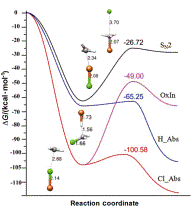| 1 Crabtree, R. H. Chem. Rev. 2010, 110, 575.  2 Schroder, D. Angew. Chem., Int. Ed. 2010, 49, 850. 2 Schroder, D. Angew. Chem., Int. Ed. 2010, 49, 850.  3 Li, J. L.; Geng, C. Y.; Huang, X. R.; Zhang, X.; Sun, C. C. Organometallics 2007, 26, 2203. 3 Li, J. L.; Geng, C. Y.; Huang, X. R.; Zhang, X.; Sun, C. C. Organometallics 2007, 26, 2203.  4 Godula, K.; Sames, D. Science 2006, 312, 67. 4 Godula, K.; Sames, D. Science 2006, 312, 67.  5 Schroder, D.; Schwarz, H. Proc. Natl. Acad. Sci. 2008, 105,18114. 5 Schroder, D.; Schwarz, H. Proc. Natl. Acad. Sci. 2008, 105,18114.  6 Li, C. J.; Trost, B. M. Proc. Natl. Acad. Sci. 2008, 105,13197. 6 Li, C. J.; Trost, B. M. Proc. Natl. Acad. Sci. 2008, 105,13197.  7 Jones, W. D.; Feher, F. J. Acc. Chem. Res. 1989, 22, 91. 7 Jones, W. D.; Feher, F. J. Acc. Chem. Res. 1989, 22, 91.  8 Vallee, F.; Mousseau, J. J.; Charette, A. B. J. Am. Chem. Soc. 2010, 132, 1514. 8 Vallee, F.; Mousseau, J. J.; Charette, A. B. J. Am. Chem. Soc. 2010, 132, 1514.  9 Li, J.; Wang, C.; Shi, J.; Guo, Q. Acta Chim. Sinica 2010,68, 1635 (in Chinese). (甋, 贬, ホ春, 尝.不, て..., 2010, 68, 1635.)10 Geng, C. Y.; Li, J. L.; Huang, X. R.; Liu, H. L.; Li, Z.; Sun, C. C. J. Comput. Chem. 2008, 29, 686. 9 Li, J.; Wang, C.; Shi, J.; Guo, Q. Acta Chim. Sinica 2010,68, 1635 (in Chinese). (甋, 贬, ホ春, 尝.不, て..., 2010, 68, 1635.)10 Geng, C. Y.; Li, J. L.; Huang, X. R.; Liu, H. L.; Li, Z.; Sun, C. C. J. Comput. Chem. 2008, 29, 686.  11 Li, J. L.; Zhang, X.; Huang, X. R. Phys. Chem. Chem. Phys.2012, 14, 24612 Sun, X. L.; Huang, X. R.; Li, J. L.; Huo, R. P.; Sun, C. C. J. Phys. Chem. A 2012, 116, 1475. 11 Li, J. L.; Zhang, X.; Huang, X. R. Phys. Chem. Chem. Phys.2012, 14, 24612 Sun, X. L.; Huang, X. R.; Li, J. L.; Huo, R. P.; Sun, C. C. J. Phys. Chem. A 2012, 116, 1475.  13 Geng, C. Y.; Ye, S.; Neese, F. Angew. Chem., Int. Ed. 2010,49, 5717. 13 Geng, C. Y.; Ye, S.; Neese, F. Angew. Chem., Int. Ed. 2010,49, 5717.  14 Holthausen, M. C.; Fiedler, A.; Schwarz, H.; Koch, W. J. Phys. Chem. 1996, 100, 6236. 14 Holthausen, M. C.; Fiedler, A.; Schwarz, H.; Koch, W. J. Phys. Chem. 1996, 100, 6236.  15 Byrd, G. D.; Burnier, R. C.; Freiser, B. S. J. Am. Chem. Soc.1982, 104, 3565. 15 Byrd, G. D.; Burnier, R. C.; Freiser, B. S. J. Am. Chem. Soc.1982, 104, 3565.  16 Sun, X. L.; Li, J. L.; Huang, X. R.; Sun, C. C. Curr. Inorg. Chem. 2012, 2, 64. 16 Sun, X. L.; Li, J. L.; Huang, X. R.; Sun, C. C. Curr. Inorg. Chem. 2012, 2, 64.  17 Sun, C. L.; Li, B. J.; Shi, Z. J. Chem. Rev. 2010, 111, 1293.18 Ackermann, L.; Vicente, R.; Kapdi, A. R. Angew. Chem., Int. Ed. 2009, 48, 9792. 17 Sun, C. L.; Li, B. J.; Shi, Z. J. Chem. Rev. 2010, 111, 1293.18 Ackermann, L.; Vicente, R.; Kapdi, A. R. Angew. Chem., Int. Ed. 2009, 48, 9792.  19 Bickelhaupt, F. M.; Ziegler, T. Organometallics 1995, 14,2288. 19 Bickelhaupt, F. M.; Ziegler, T. Organometallics 1995, 14,2288.  20 Fisher, E. R.; Sunderlin, L. S.; Armentrout, P. B. J. Phys. Chem. 1989, 93, 7375. 20 Fisher, E. R.; Sunderlin, L. S.; Armentrout, P. B. J. Phys. Chem. 1989, 93, 7375.  21 Fisher, E. R.; Schwarz, H.; Armentrout, P. B. J. Phys. Chem. 1989, 93, 7382. 21 Fisher, E. R.; Schwarz, H.; Armentrout, P. B. J. Phys. Chem. 1989, 93, 7382.  22 Neese, F. ORCA -an ab initio, Density Functional and Semiempirical Program Package 2010, Version 2.8, Bonn University, Germany, 2010. 22 Neese, F. ORCA -an ab initio, Density Functional and Semiempirical Program Package 2010, Version 2.8, Bonn University, Germany, 2010.  23 Chen, H.; Lai, W.; Shaik, S. J. Phys. Chem. Lett. 2010, 1,1533. 23 Chen, H.; Lai, W.; Shaik, S. J. Phys. Chem. Lett. 2010, 1,1533.  24 Weigend, F.; Ahlrichs, R. Phys. Chem. Chem. Phys. 2005,7, 3297.25 Diefenbach, A.; Bickelhaupt, F. M. J. Phys. Chem. A 2004,108, 8460. 24 Weigend, F.; Ahlrichs, R. Phys. Chem. Chem. Phys. 2005,7, 3297.25 Diefenbach, A.; Bickelhaupt, F. M. J. Phys. Chem. A 2004,108, 8460.  26 Zhao, X.; Hopkinson, A. C.; Bohme, D. K. ChemPhysChem2008,, 9, 873. 26 Zhao, X.; Hopkinson, A. C.; Bohme, D. K. ChemPhysChem2008,, 9, 873.  |
